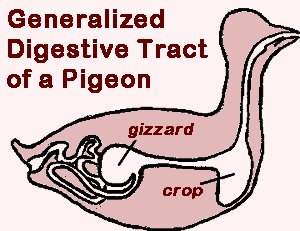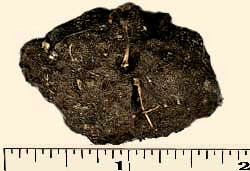
- bill
- mouth
- tongue
- pharynx
- esophagus
- crop
- stomach
- proventriculus
- gizzard
- small intestine
- caeca
- rectum
- cloaca
A typical bird's digestive tract is usually considered to consist of the parts listed at the right. You know what the bill, mouth and tongue are. The pharynx (FAIR-ingx) is the part between the mouth and the esophagus, much involved with swallowing. The esophagus is the tube leading down from the pharynx.
THE CROP:
Not present in all birds, the crop serves more or less as a "doggy bag" when the bird eats. Notice the crop in the picture above. Let's say you're a Song Sparrow and you discover a weed just loaded with delicious-looking seeds, but the weed grows in the open. If you flit into the open area to eat the weed's seeds, you're making yourself vulnerable to predators who want to eat you. What to do?
What you do is to flit into the open and gobble up those seeds far faster than any stomach could possibly handle them, then fly to safety. You can do this because of your crop. For, as you cram in those seeds, a few at first go straight to the gut but, when that fills, further seeds begin detouring to the bag-like crop. Once the crop is full of seed, you fly to your favorite perch, and now there's not much to do but let your stomach digest. As those first seeds in the stomach begin working their way through the rest of the body, seeds stored in the crop automatically refill the stomach. If someday you pick up a bird, perhaps one that has flown into a window and you want to save it from the cat, if that bird has recently eaten, you well may be able to feel the crop in the chest area, feeling like a bag filled with grit right below the feathers.
Actually, specialists in the field of bird guts would want to insist that some birds have real crops, other birds have "pseudocrops," and that there are other croplike variations, but we don't want to get too confused so we'll just leave it at that.
THE TWO-CHAMBERED STOMACH:
- The proventriculus:
The stomach is an amazing affair consisting of two chambers. The proventriculus is the first chamber. It secretes an acid for breaking down food, and is best developed in birds that swallow entire fish and other animals containing bones which must be digested. If you know a little chemistry, you'll know how amazing it is that bird stomach-acid can have a pH as low as 0.2. In most of North America there's a kind of bird known as a shrike, which eats small animals, especially rodents and songbirds. A shrike's well developed first stomach-chamber can digest an entire mouse in only three hours! - The gizzard:
The bird stomach's second chamber is known as the gizzard. If you've ever eaten a chicken gizzard you know how tough and rubbery it is. To accomplish what the gizzard does, it absolutely must be tough, for the gizzard's main function is to grind and digest tough food. Though the gizzard consists of very powerful muscles, it alone can't pulverize everything the typical bird eats; you know how hard uncooked rice and corn kernels are, and these aren't even considered hard types of grain.
products of a special gizzard
 Several hours after an owl eats, the fur, bones, teeth & feathers of its prey still in the gizzard are compressed into a pellet the same shape as the gizzard. In the above photo you can see white bones enmeshed in a mass of fur and feathers. Once formed, the pellet moves up from the gizzard to the proventriculus, where it remains for up to 10 hours before being regurgitated. Owls can't eat while a fully formed pellet is present, blocking the digestive track. When an Owl is ready to produce a pellet it usually closes its eyes, gets a funny luck in its face, doesn't want to fly and, when the pellet is ready to come out, the beak is opened and the pellet simply drops out. Other birds of prey, such as hawks, also produce pellets but the owl's digestive juices are less acidic than those of other birds of prey, so there is more material present to form a pellet. The pellet above is from a Barn Owl, Tyto alba.
Several hours after an owl eats, the fur, bones, teeth & feathers of its prey still in the gizzard are compressed into a pellet the same shape as the gizzard. In the above photo you can see white bones enmeshed in a mass of fur and feathers. Once formed, the pellet moves up from the gizzard to the proventriculus, where it remains for up to 10 hours before being regurgitated. Owls can't eat while a fully formed pellet is present, blocking the digestive track. When an Owl is ready to produce a pellet it usually closes its eyes, gets a funny luck in its face, doesn't want to fly and, when the pellet is ready to come out, the beak is opened and the pellet simply drops out. Other birds of prey, such as hawks, also produce pellets but the owl's digestive juices are less acidic than those of other birds of prey, so there is more material present to form a pellet. The pellet above is from a Barn Owl, Tyto alba.Something other than muscle power is needed. This "something else" is acquired when grain-eating birds pick up grit and small rocks as they peck seeds from the ground.
This mineral matter accumulates in the gizzard, and ultimately the gizzard grinds the particles against the seeds, smashing them. Turkey gizzards can actually pulverize English walnuts and steel needles! Bird species that eat softer food possess less well developed gizzards. In some species, the gizzard remains small and insignificant during the summer when the diet consists of soft food such as flesh, insects, or fruit, but it grows more powerful during the winter when seeds are the main food. Since birds eat such a wide variety of foods, you can imagine that variations on the stomach theme are many. One of the most elegant is found among grebes, which are very common water-birds you're bound to see if you visit local lakes or the seashore. Grebes swallow their own feathers, which accumulate in the region between the gizzard and the intestine following it. This feather-clogged zone then serves as a filter for sharp fish bones that somehow make it past the stomach.
BEYOND THE STOMACH:
Once food leaves the gizzard, its voyage through the intestines is fairly similar to that taken by food in our own intestines; nutrients are absorbed into the body, and waste is eventually excreted. Intestines are short in birds which eat easily absorbed food, such as fruit, flesh, and insects, but long in species eating seeds, plants, and fish. Swifts, which are insect-eating birds you'll see skating across the suburban summer sky, possess intestines only about three times their body length. In contrast, intestines of vegetarian ostriches are roughly twenty times their body length. Easily absorbed berries pass through a thrush's intestine in less than half an hour, while rougher food may need half a day or more.
The word "caeca"; (SEE-kah)is the plural form of caecum (SEE-kum), and the plural form is used here because birds usually have two. Caeca are very variable among the species, often looking like two little worms stuck at the end of the intestines. Their usual function appears to be to aid in the absorption of water and proteins, and the microbial decomposition of fiber.
The rectum is the last part of the large intestine in humans, and no digestion or absorption of food takes place there. The cloaca (klo-A-ka) is the end of the line where waste from the digestive and urinary tract, and a little other stuff, accumulate before being dumped.